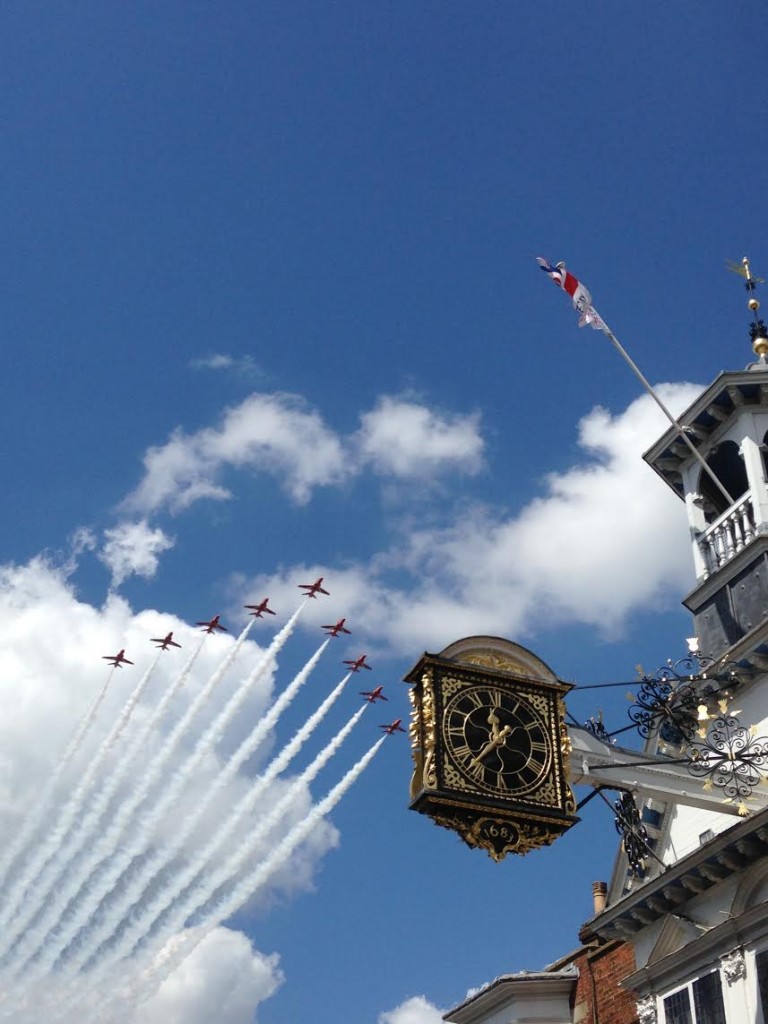- Stay Connected
 Abraham Lincoln
If given the truth, the people can be depended upon to meet any national crisis...
Abraham Lincoln
If given the truth, the people can be depended upon to meet any national crisis...
 Guildford news...
for Guildford people, brought to you by Guildford reporters - Guildford's own news service
Guildford news...
for Guildford people, brought to you by Guildford reporters - Guildford's own news service
Red Arrows Captured in Guildford
Published on: 6 Jul, 2015
Updated on: 7 Jul, 2015
A Guildford Dragon NEWS reader, Jayne Marks, has sent this perfectly timed picture of the Red Arrows flying over the High Street on Armed Forces Day.
The combination of the precision formation, Guildford’s iconic Guildhall clock and the blue and white background form a striking image.
We at The Dragon would like to thank Jayne for sharing this with us and our readers to enjoy. Another reader, Harry Eve, took this picture as some of the Red Arrows flew over Horsley.
If you have an images, perhaps from Saturday’s Raft Race, perhaps of the wonderful Alice in Wonderland themed Castle Grounds, perhaps a local nature photo, why not send it in too? guildford.dragon@gmail.com
And if you would like to see more watch the Youtube video below…
And a bit of history from Wikipedia…
Predecessors to the Red Arrows
The Red Arrows were not the first RAF aerobatics team. An RAF pageant was held at Hendon in 1920 with teams from front-line biplane squadrons. In 1938, three Gloster Gladiators flew with their wing-tips tied together. Formation aerobatics largely stopped during the Second World War.
In 1947, the first jet team of three de Havilland Vampires came from RAF Odiham Fighter Wing. Various teams flew the Vampire, and in 1950, No. 72 Squadron was flying a team of seven. No. 54 Squadron became the first RAF jet formation team to use smoke trails. Vampires were replaced by Gloster Meteors, No. 66 Squadron developing a formation team of six aircraft.
Hawker Hunter aircraft were first used for aerobatics teams in 1955, when No. 54 Squadron flew a formation of four.
The official RAF team was provided by No. 111 Squadron in 1956, and for the first time the aircraft had a special colour scheme, which was an all-black finish. After a demonstration in France, they were hailed as “Les Fleches Noires” and from then on known as the Black Arrows. This team became the first team to fly a five-Hunter formation. In 1958 the Black Arrows performed a loop and barrel roll of 22 Hunters; a world record for the greatest number of aircraft looped in formation. The Black Arrows were the premier team until 1961, when the Blue Diamonds (No. 92 Squadron) continued their role, flying sixteen blue Hunters.
In 1960, the Tigers (No. 74 Squadron) were re-equipped with the supersonic English Electric Lightning and performed wing-overs and rolls with nine aircraft in tight formation. They sometimes gave co-ordinated displays with the Blue Diamonds.
Yet another aerobatics team was formed by No. 56 Squadron, the Firebirds, with nine red and silver Lightnings. In 1964, the Red Pelicans, flying six BAC Jet Provost T Mk 4s, assumed the role of the RAF’s leading display team. In that same year, a team of five yellow Gnat trainers from No 4 Flying Training School displayed at the Farnborough Airshow. This team became known as the Yellowjacks after Flight Lieutenant Lee Jones’s call sign, “Yellowjack”.
In 1964, all the RAF display teams were amalgamated, as it was feared pilots were spending too much time practising formation aerobatics rather than operational training. The new team name took the word red from the fact that the Yellowjacks’ planes had been painted red (for safety reasons, as it was a far clearer and more visible colour in the sky) and arrows after the Black Arrows; the official version, however, is that the red was a tribute to the Red Pelicans. Another reason for the change to red was that responsibility for the team moved from Fighter Command to the Central Flying School, whose main colour was red.














Recent Comments